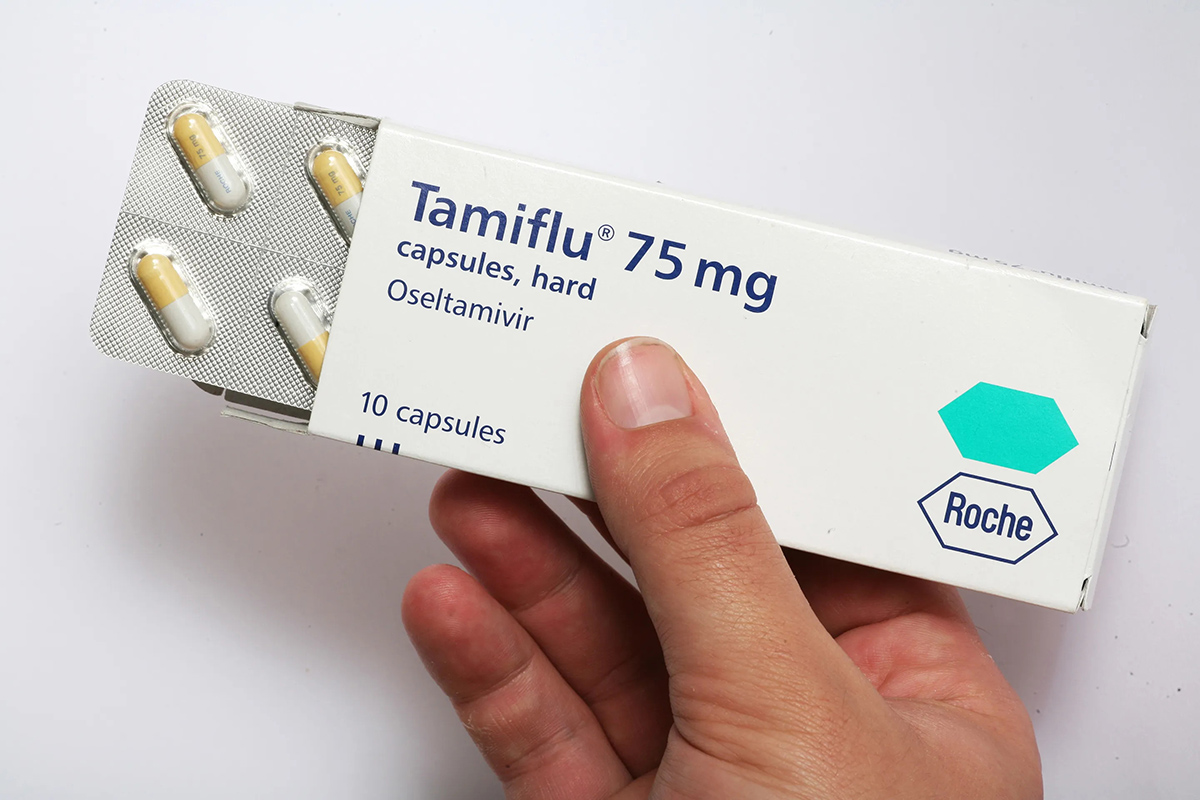

Finance
How Much Is Tamiflu With Insurance?
Published: November 18, 2023
Find out the cost of Tamiflu with insurance and manage your finances effectively. Discover how to save and plan for medical expenses.
(Many of the links in this article redirect to a specific reviewed product. Your purchase of these products through affiliate links helps to generate commission for LiveWell, at no extra cost. Learn more)
Table of Contents
Introduction
When flu season hits, one of the most common prescriptions doctors give is Tamiflu. Tamiflu is an antiviral medication used to treat and prevent influenza (flu) virus infections. It is highly effective in reducing the severity and duration of flu symptoms, helping patients recover faster.
However, the cost of Tamiflu can be a concern for many individuals, especially those without insurance coverage. The good news is that having insurance can help alleviate some of the financial burden associated with Tamiflu treatment. Insurance coverage can significantly reduce the out-of-pocket expenses for the medication, making it more accessible to those in need.
This article aims to provide an in-depth understanding of how much Tamiflu costs with insurance coverage. We will explore the factors that can influence the cost of Tamiflu with insurance, such as co-pays, deductibles, and generic versus brand name versions of the medication. Additionally, we will discuss the use of prescription drug discount cards and other strategies to save on Tamiflu costs.
By the end of this article, you will have a clear understanding of how insurance can impact the cost of Tamiflu and the different ways you can save money on this important medication.
Understanding Tamiflu
Tamiflu is the brand name for the drug oseltamivir phosphate. It belongs to a class of medications called neuraminidase inhibitors, which work by blocking the action of the neuraminidase enzyme produced by the influenza virus. By inhibiting this enzyme, Tamiflu helps to prevent the virus from spreading within the body and reduces the severity and duration of flu symptoms.
Tamiflu is available in two forms: capsules and oral suspension. The dosage and duration of treatment can vary depending on factors such as age, weight, and severity of symptoms. It is typically prescribed for individuals who are at high risk of developing flu-related complications, such as young children, older adults, and individuals with weakened immune systems.
It is important to note that Tamiflu is not a substitute for the flu vaccine. While vaccination is the best way to prevent the flu, Tamiflu can be prescribed for individuals who have already contracted the virus or have been in close contact with someone who has the flu.
It is essential to start Tamiflu treatment as early as possible after flu symptoms appear. The medication is most effective when taken within the first 48 hours of symptom onset. Common side effects of Tamiflu can include nausea, vomiting, headache, and diarrhea, but these are usually mild and temporary.
Now that we have a basic understanding of Tamiflu, let’s explore how insurance coverage can impact its cost and accessibility.
The Importance of Insurance
Insurance plays a crucial role in healthcare by providing financial protection and access to necessary medical treatments and medications. When it comes to prescription medications like Tamiflu, having insurance coverage can significantly impact the cost and accessibility of the medication.
One of the primary benefits of having insurance is that it helps to alleviate the financial burden of healthcare expenses. Without insurance, the cost of Tamiflu can be quite high, making it unaffordable for many individuals. Insurance coverage can help reduce the out-of-pocket expenses for Tamiflu, making it more accessible to those who need it.
Having insurance also provides a sense of security, knowing that you have coverage in case of unexpected medical situations. In the case of flu season, having insurance can give you peace of mind knowing that you can seek timely medical care and obtain necessary medications like Tamiflu without excessive financial strain.
Furthermore, insurance coverage for Tamiflu extends beyond just the cost savings. It also ensures that you receive the medication from reputable sources. Insurance plans have pharmacy network agreements that ensure the quality and safety of the medications they cover, including Tamiflu. This helps to ensure that you are receiving a genuine and effective product.
Insurance coverage for Tamiflu also promotes responsible healthcare practices. When individuals have insurance, they are more likely to follow through with doctor’s visits and receive appropriate treatments. This helps to reduce the spread of the influenza virus, minimize hospitalizations, and improve overall public health.
Ultimately, having insurance coverage for Tamiflu is crucial for both individual health and the well-being of the community. It provides a safety net against the financial burden of healthcare expenses while ensuring timely access to necessary medications. In the next section, we will explore the factors that can affect the cost of Tamiflu with insurance.
Factors Affecting Tamiflu Cost with Insurance
Several factors can influence the cost of Tamiflu with insurance coverage. Understanding these factors can help individuals better navigate the healthcare system and make informed decisions regarding their prescription medication expenses. Here are some key factors to consider:
Coverage and Co-pays:
The specific insurance plan you have will dictate the level of coverage for prescription medications like Tamiflu. Some insurance plans may cover the full cost of Tamiflu, while others may require you to pay a co-pay, which is a fixed amount or percentage of the medication’s cost. Reviewing your insurance policy and understanding your co-pay obligations can give you a clearer idea of how much you will need to pay for Tamiflu.
Deductibles and Out-of-pocket Expenses:
Insurance plans often have deductibles, which is the amount you must pay out-of-pocket before your insurance coverage kicks in. If you have not met your deductible, you may be responsible for the full cost of Tamiflu until you reach that threshold. Additionally, even after meeting your deductible, you may still have out-of-pocket expenses, such as co-insurance or co-pays. Being aware of these costs can help you budget for your Tamiflu prescription.
Generic versus Brand Name Tamiflu:
Another factor that can affect the cost of Tamiflu with insurance is whether you opt for the generic or brand name version of the medication. Generic drugs are typically cheaper than their brand name counterparts because they do not have the same research and development costs. If your insurance plan covers generic medications and Tamiflu has a generic equivalent, choosing the generic option can help lower the overall cost.
Pharmacy Choice:
Your choice of pharmacy can also impact the cost of Tamiflu with insurance. Insurance plans often have negotiated rates with specific pharmacies, which can result in lower prices for medications. It’s a good idea to check with your insurance provider to see if they have a preferred pharmacy network and choose a participating pharmacy to save on Tamiflu costs.
By taking these factors into account, you can have a better understanding of how insurance coverage can affect the cost of Tamiflu. In the next sections, we will explore specific aspects related to insurance coverage, such as co-pays, deductibles, and generic options, in more detail.
Coverage and Co-pays
When it comes to insurance coverage for Tamiflu, understanding the terms of your plan is crucial. The specific coverage and co-pays associated with Tamiflu will vary depending on your insurance provider and policy. Here are some important points to consider:
Insurance Coverage:
Insurance plans typically have a formulary, which is a list of covered medications. Tamiflu may or may not be included in this list, so it’s essential to review your plan documents or contact your insurance provider to confirm whether Tamiflu is covered.
If Tamiflu is covered by your insurance, the level of coverage can vary. Some plans may cover the full cost of Tamiflu, while others may require you to pay a percentage of the cost as a co-insurance or a fixed dollar amount as a co-pay.
Co-pays:
A co-pay is a predetermined fee that you pay out-of-pocket for a medication. It is often a flat fee, such as $10 or $20, but can also be a percentage of the medication’s cost.
When it comes to Tamiflu, the co-pay amount can vary depending on your insurance plan. Some plans may have a lower co-pay for generic Tamiflu and a higher co-pay for the brand name version. It’s important to check with your insurance provider to understand what your specific co-pay for Tamiflu will be.
Tiered Formularies:
In some cases, insurance plans may have tiered formularies, dividing medications into different tiers based on their cost. Tamiflu may be categorized as a Tier 1 or Tier 2 medication, which typically have lower co-pays, while brand name Tamiflu may be in a higher tier with a higher co-pay. Understanding the tiers within your formulary can help you anticipate the cost of Tamiflu.
It’s important to note that insurance coverage and co-pays can change from year to year, so it’s a good idea to review your plan annually and make sure Tamiflu is still covered and the co-pay amount is known.
By understanding your insurance coverage and co-pays associated with Tamiflu, you’ll have a better idea of the out-of-pocket expenses you can expect. In the next section, we will explore another factor that can impact the cost of Tamiflu with insurance: deductibles and out-of-pocket expenses.
Deductibles and Out-of-pocket Expenses
When it comes to the cost of Tamiflu with insurance, deductibles and out-of-pocket expenses are important factors to consider. Let’s take a closer look at how these factors can affect the overall cost:
Deductibles:
A deductible is the amount you must pay out-of-pocket for healthcare services and medications before your insurance coverage kicks in. Insurance plans often have an annual deductible, which means you have to meet this amount each year before your insurance coverage begins to pay for any expenses.
If you have not yet met your deductible for the year, you may be responsible for the full cost of Tamiflu until the deductible is satisfied. The cost of Tamiflu during this time will not be reduced by insurance, and you will be required to pay the full cost out-of-pocket.
Out-of-pocket Expenses:
In addition to deductibles, insurance plans often set a limit on the total amount of out-of-pocket expenses you have to pay each year. Once you have reached this limit, known as the out-of-pocket maximum, your insurance coverage will typically cover the full cost of approved medical expenses, including Tamiflu.
If you have already met your deductible for the year and have reached your out-of-pocket maximum, your insurance plan will cover the cost of Tamiflu, and you will have little to no out-of-pocket expenses for the medication.
It’s important to note that deductibles and out-of-pocket maximums can vary widely depending on your insurance plan. Some plans may have high deductibles and out-of-pocket maximums, while others may have lower amounts. It’s crucial to understand these amounts and factor them into your budgeting for Tamiflu costs.
Monitoring your deductible and out-of-pocket expenses can help you plan and budget for the cost of Tamiflu. It’s advisable to keep track of your healthcare expenses throughout the year, including any payments made towards your deductible and out-of-pocket maximum, to ensure you are aware of how much you have spent and how much is left to reach those thresholds.
Next, we will explore the difference between generic and brand name Tamiflu and how it can impact the cost with insurance coverage.
Generic versus Brand Name Tamiflu
When it comes to Tamiflu, there is the option to choose between the generic and brand name versions of the medication. Understanding the difference between these options can help you make an informed decision about which one to choose and how it can impact the cost with insurance coverage.
Generic Tamiflu:
Generic Tamiflu, also known as oseltamivir, is a medication that contains the same active ingredient as the brand name version. Generic medications are created after the patent protection on the brand name version expires. They are typically cheaper because they do not have to undergo the same extensive research and development process.
If your insurance plan covers generic medications, choosing the generic version of Tamiflu can help reduce the overall cost. Generic medications are generally less expensive than their brand name counterparts, and your insurance coverage may have lower co-pays or co-insurance for generic drugs.
Brand Name Tamiflu:
Brand name Tamiflu is the original version of the medication. It was the first to receive approval from regulatory authorities and is typically more expensive than generic Tamiflu. Brand name medications often come with higher co-pays or co-insurance compared to generics.
While brand name Tamiflu may be more expensive, some individuals may opt for it due to specific preferences or their insurance plan’s coverage. It’s important to review your insurance policy or contact your insurance provider to understand how brand name Tamiflu is covered and what costs you can expect.
It’s worth noting that both generic and brand name versions of Tamiflu contain the same active ingredient and are equally effective in treating and preventing influenza. The choice between the two comes down to personal preference and the financial implications.
If you are interested in saving on Tamiflu costs, inquire about the availability of a generic version through your healthcare provider or pharmacy. Your insurance provider can also provide guidance on coverage for generic versus brand name Tamiflu.
In the next section, we will explore the use of prescription drug discount cards as another strategy to save on Tamiflu costs with insurance coverage.
Utilizing Prescription Drug Discount Cards
Prescription drug discount cards can be a helpful tool in reducing the cost of medications like Tamiflu, even when you have insurance coverage. These discount cards, often available for free or at a minimal cost, provide additional savings on top of your insurance plan’s coverage. Here’s how they work:
How Prescription Drug Discount Cards Work:
Prescription drug discount cards work by providing access to negotiated discounted prices for medications at participating pharmacies. These cards are not insurance, but they can be used alongside your insurance coverage to help lower your out-of-pocket costs.
With a prescription drug discount card, you can present it to the pharmacist when filling your Tamiflu prescription. The card’s discounts are then applied to the medication, potentially reducing the co-pay or co-insurance amount you would have otherwise paid out-of-pocket.
Benefits of Prescription Drug Discount Cards:
The use of prescription drug discount cards can provide several benefits, including:
- Additional Savings: Discount cards can offer additional savings and help reduce the financial burden of Tamiflu and other prescription medications.
- Wide Acceptance: Many pharmacies accept prescription drug discount cards, including major chains and independent pharmacies.
- No Restrictions: Discount cards often have no restrictions based on income, age, or pre-existing conditions, making them accessible to a wide range of individuals.
- No Exclusions: Unlike some insurance plans, discount cards typically have no formulary or restrictions on specific medications, allowing you to save on Tamiflu and other prescribed drugs.
- Easy to Use: Prescription drug discount cards are simple to use. You present the card during the prescription filling process, and the discounts are applied automatically.
It’s important to research and compare different prescription drug discount cards to find one that offers the best savings for your specific medication needs. Some cards may have partnerships with specific pharmacies or offer additional benefits, such as mail-order delivery or discounts on other healthcare services.
Before utilizing a prescription drug discount card, it’s recommended to check with your insurance provider to ensure that using the card won’t affect your insurance coverage. In some cases, the discounted amount may not count towards your insurance plan’s deductible or out-of-pocket maximum.
By utilizing prescription drug discount cards, you can further reduce the cost of Tamiflu and maximize your savings, making the medication more affordable and accessible.
In the next section, we will explore other strategies and resources available to help save on Tamiflu costs with insurance coverage.
Other Ways to Save on Tamiflu Costs
Aside from insurance coverage and prescription drug discount cards, there are other strategies and resources available to help save on Tamiflu costs. These options can be particularly valuable for individuals who do not have insurance or have limited coverage for prescription medications. Here are some ways to consider:
Patient Assistance Programs:
Pharmaceutical manufacturers often offer patient assistance programs (PAPs) for individuals who cannot afford the cost of their medications. These programs provide financial assistance or free medication to eligible individuals. If you do not have insurance coverage for Tamiflu or are facing financial hardship, it’s worth exploring whether there are PAPs available for assistance.
Comparison Shopping:
Prices for medications can vary significantly between different pharmacies. It’s worthwhile to compare prices at various pharmacies in your area to find the best deal for Tamiflu. Online platforms and apps can help you compare prices and find the most affordable option.
Mail-order Pharmacy Services:
Some insurance plans offer mail-order pharmacy services, allowing you to order medications, including Tamiflu, in bulk. Mail-order pharmacies often provide medications at a lower cost due to savings on overhead expenses. This option can be particularly advantageous for individuals who require Tamiflu on a regular basis or have a long-term prescription.
Manufacturer Coupons:
Pharmaceutical manufacturers may offer coupons or vouchers for their medications, including Tamiflu. These discounts can help reduce the out-of-pocket cost when filling your prescription. Visit the manufacturer’s website or speak with your healthcare provider to inquire about any available coupons or savings programs.
Generic Alternatives:
If Tamiflu is not covered by your insurance or the cost is prohibitive, consult with your healthcare provider to explore generic alternatives. They can recommend alternative medications that may be more affordable while providing similar benefits in treating and preventing the flu.
It’s important to discuss these options with your healthcare provider or pharmacist to ensure that they are suitable for your specific circumstances and medical needs. They can provide valuable guidance and assistance in navigating the various resources available to save on Tamiflu costs.
By exploring these additional strategies and resources, you can find ways to make Tamiflu more affordable, even if you have limited insurance coverage or no insurance at all.
Now let’s wrap up and conclude our discussion on Tamiflu costs with insurance coverage.
Conclusion
Understanding the cost of Tamiflu with insurance coverage is crucial for individuals seeking treatment for the flu virus. Insurance coverage plays a vital role in making Tamiflu more accessible and affordable, reducing the financial burden on those in need of this essential medication. However, several factors can influence the cost with insurance, including coverage and co-pays, deductibles and out-of-pocket expenses, and the choice between generic and brand name Tamiflu.
It is important to review your insurance policy to understand the specific coverage and co-pays associated with Tamiflu. Deductibles and out-of-pocket expenses can also impact how much you will need to pay for the medication. Choosing between generic and brand name Tamiflu can further affect the cost, as generic options tend to be more affordable.
In addition to insurance coverage, there are other strategies to consider to save on Tamiflu costs. Prescription drug discount cards can provide further discounts on top of insurance coverage, while patient assistance programs offered by pharmaceutical manufacturers can offer financial assistance for those without insurance or facing financial hardship. Comparison shopping, mail-order pharmacy services, manufacturer coupons, and exploring generic alternatives are additional avenues to explore for potential savings.
By taking advantage of these options and being proactive in understanding your insurance coverage, co-pays, and available discounts, you can effectively navigate the cost of Tamiflu and make it more affordable.
Remember, Tamiflu is a highly effective medication for treating and preventing the flu, particularly for individuals at higher risk of complications. If you experience flu symptoms or have been in close contact with someone with the flu, it is crucial to seek medical attention and discuss Tamiflu with your healthcare provider.
Overall, with the right knowledge and resources, you can minimize the financial impact of Tamiflu and prioritize your health during flu season.














